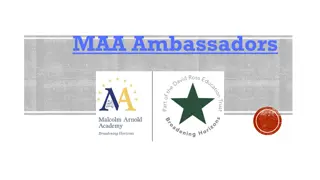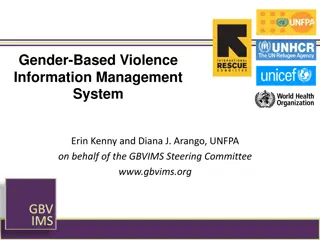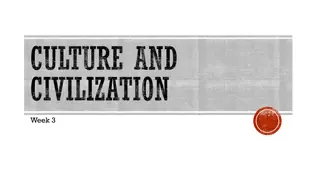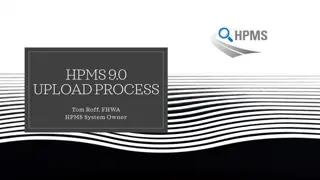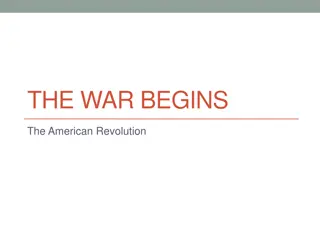
Value Creation in Clinically Integrated Supply Chain Partnerships
Explore the journey of creating value through strong partnerships in a clinically integrated supply chain, emphasizing stakeholder collaboration, engagement techniques, and value analysis initiatives. Learn how to drive standardization, enhance communication, and prepare clinicians for change in healthcare supply chain management.
Download Presentation

Please find below an Image/Link to download the presentation.
The content on the website is provided AS IS for your information and personal use only. It may not be sold, licensed, or shared on other websites without obtaining consent from the author. If you encounter any issues during the download, it is possible that the publisher has removed the file from their server.
You are allowed to download the files provided on this website for personal or commercial use, subject to the condition that they are used lawfully. All files are the property of their respective owners.
The content on the website is provided AS IS for your information and personal use only. It may not be sold, licensed, or shared on other websites without obtaining consent from the author.
E N D
Presentation Transcript
Creating Value Through Strong Partnerships in a Clinically Integrated Supply Chain Erin Arnold, MSN, RN, CNOR
Disclosures The presenters have no real or perceived conflicts of interest related to this presentation Note: This program may contain the mention of suppliers, brands, products, services or drugs presented in a case study or comparative format using evidence-based research. Such examples are intended for educational and informational purposes and should not be perceived as an endorsement of any particular supplier, brand, product, service or drug. 2
Learning Objectives At the end of this session, participants should be able to: 1. Describe ways to partner with key stakeholders in driving standardization initiatives, including Physician Preference Items Discuss engagement and communication techniques to improve initiative implementation increase stakeholder buy-in Suggest techniques and processes to prepare clinicians for change 2. 3. 3
Audience Poll Question: #1 of 3 What techniques do you utilize to gain consensus and support from clinicians when evaluating Supply Chain opportunities? a. Clinician Led Value Analysis Committees b. Strategic Sourcing/Contracting Strategies c. Data Analytics Cost, Quality & Outcomes d. Third Party Evidence Database e. Supply Chain Led Committees f. Administration Mandates g. Tell a Story with Financial Numbers h. Combination of Above 5
Value Analysis Journey Value Analysis Policy and Procedures created Foundation for cost, quality and patient outcomes Enterprise Contracting and Value Analysis process put in place End users place requests for items to be added to contract Local Facility Value Analysis teams work to implement initiatives Some corporate, some local Enterprise Clinical Value Analysis Teams launched General Medical Surgery Laboratory Cardiac Physician Advisory Boards Concept Executive Steering Committee formed 6
Value Analysis Journey Enterprise Value Analysis teams historically had only Contracting, Purchasing, Facility Materials Directors/Managers and little clinical participation Decisions were made around cost and not much clinical input into initiatives Implementations stalled, not much facility level support to drive initiatives to completion Local Facility VATs were siloed and working autonomously on own initiatives Relaunch of Value Analysis Program June 2020 COVID-19 Delays PPE Sourcing and Acquisition February-June More focus on clinical feedback and engagement Front end Buy-in for difficult and clinically sensitive product categories Majority of team members are now clinicians Robust participation and discussion around new initiatives 7
Value Analysis Journey Communication tools and resources improvement Physician recruitment for championing initiatives PPI Cellular Regenerative Tissue Total Joints Hip and Knee Spine/Osteobiologics Ortho Trauma Small Joints Understanding Limitations 2 ERP systems, 2 EHR systems Future state- 1 ERP & 1 HER 8
Audience Poll Question: #2 of 3 What communication techniques does your organization use when implementing change, specifically with standardization initiatives? a. Newsletters b. Leadership Communication c. Comprehensive Conversion Launch Packages d. 1:1 Meetings e. Value Analysis Meetings f. Intranet Communication g. Combination of the Above h. Any Others? 9
Improved Communication Tools Contract/Initiative Launch Packages Feedback from end users on ways to improve communication and needed items to facilitate conversions Initiative scope statement is comprehensive in scope of project, spend, savings, rationale, key stakeholders, literature, and patient outcome impacts Comprehensive Cross References with Visuals Ethicon Mesh Bard Davol Cross Ethicon Prolene Mesh Davol Bard Mesh SPMXXL PMII SPMH PMH PML 0112660 0112680 0112720 10
Value Analysis Journey Communication Tools Continued Executive Communication Prior to Initiative Launch Memo to Regional and Facility Leadership Teams Ensures leadership is aware and supportive of change Monthly Newsletters Savings Scorecard Validation of launched initiatives and contract renewals Evolved over time includes missed opportunities, capital, cost increases, cost avoidance and rebate tracking Supply Chain Initiative Dashboard Tracker Itemized year over year tracker Quick snapshot of each initiative s progress, spend and potential savings 11
Rationale for Change, Partnership and Improvement
Audience Poll Question: #1 of 3 What are the benefits of Standardization in a Healthcare Organization? a. Increased Competency of Staff b. Improved Efficiency of Ordering and Maintaining Supplies c. Decrease in Costs d. Potentially Improved Patient Outcomes e. Standardization of Patient Care f. All the Above 13
Rationale for Change, Partnership and Improvement Why Should we Standardize? Variation in supplies across organization Clinical staff need to understand nuances of each item and each surgeon Creates variation in care delivery Drives increase in waste Variation in cost per case Consistency drives competence which improves patient care outcomes and employee satisfaction 14
Rationale for Change, Partnership and Improvement Why Should we Standardize? Inventory control and efficiency Reduction in SKUs Less products to manage Redundancy in market Clinical equivalency of lower cost items Does the literature support higher cost items? Most times the literature does not exist, or the evidence is inconclusive; not enough studies and evidence to show differentiation in product and patient care outcomes Is there consistency among practitioners to support practice-based evidence? Consolidate multi-source, dual source, and leverage sole-source contracts Consider implications of sole source 15
Partnering with Key Stakeholders Who are Key Stakeholders in Value Analysis Process? Patients Clinicians All end users of products and clinical process Physicians, Nurses, Therapists, Technicians, Care Assistants, EVS, etc. Executive Leadership C-Suite (Local, Regional and Corporate) Leadership Regional and Local Facility Supply Chain Contracts, Value Analysis, Procurement, Data, Operations Vendors Finance GPO 16
Partnering with Key Stakeholders How do we Partner with Key Stakeholders? Communication, Communication, Communication!!! Proactive communication yields the best results Communicating the message effectively Team approach, not top-down communication Soliciting feedback on products, gathering committee s clinical opinion on product equivalence End users many times do not know what items cost Data! Prepare to discuss current costs, potential costs and vendor options Leadership Support Proactive communication to Executive Leadership and OR Leadership They help to remove barriers and mitigate issues and concerns Partner with Vendor reps They help with education and support messaging Routine weekly check-ins to ensure implementation is progressing Ensure consistent messaging/talking points throughout each initiative 17
XXXXX Initiative Evaluation Form Example of Communication Package Name of Person Completing Form Location Procedure Comprehensive Package that includes the following: Bone Cement Cement Mixing Accessories Product(s) evaluated - Please Circle Please put an" X" in the appropriate column for your feedback Ensure rationale is clear for why the change Project Scope Statement Cross References Evaluation Forms Literature supporting the change and new product Financial Savings Implementation Plan Staff & Leadership Memo Questions Did the vendor provide adequate training and education? Did the vendor provide clinical support during the evaluation? Product(s) easy to use? Product(s) performed as expected? Did you experience equivalent or better patient care outcomes using this product compared to current product? Is the XXXXXX Products clinically acceptable? Do you support conversion to the XXXXXXX Products and Initiatve? Totals Strongly Agree (5) Agree (4) Disagree (3) Strongly Disagree (2) N/A, (1) If score of 2 or below, please supply comments in the section below. Please submit completed form to facility Materials Director
Partnering with Key Stakeholders How do we Partner with Key Stakeholders? Ensure mechanisms for feedback and appeals Appeal Process clearly defined Communicate regularly with surgeon champions
Case Studies Bone Cement and Accessories Synthetic Non-Absorbable Hernia Mesh Rationale for Change Change Management process Buy-In Partnering with Surgeons, OR clinicians, and leadership What went well? Barriers to implementation? Lessons learned? What suggestions for future initiatives? Current State Rationale for Change Change Management process Buy-In Partnering with Surgeons, OR clinicians, and leadership What went well? Barriers to implementation? Lessons learned? What suggestions for future initiatives? Current State 21
Continuous Process Improvement Future State Implement Processes to debrief after implementation Communication with Stakeholders on opportunities for Improvement What went well? What can we improve? How do we improve communication? Did we achieve the goals based on the Initiative Scope Statement? How far were we off? Implementing KPIs Speed to Value How quickly did we implement the initiatives to realize savings, SKU reduction, etc? Contract Performance Supplier Scorecard 22
Thank you!!! Thank you!!!




